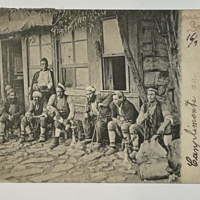Botanists differ on whether the sativas, the CBD-bearing varieties of cannabis, evolved naturally or through centuries of careful human intervention. Our modern ability to read the genetic code of botanical samples has advanced the natural breeding theory. The genetic evidence indicates that the sativa varieties evolved in small, isolated populations that survived the ice ages and not through human intervention.
For over 75 years, apothecares carefully distinguished the sativas from the indicas. This was their way of providing materials that reliably provided either CBD or THC. This series of apothecary jars distinguishing the difference shows that this discrimination was universal across the profession.
The outcome of cross breeding Cannabis sativa and Cannabis indica in America.(show chart with hemp and marijuana.)
Going back to our chart, we can see that the CBD-bearing sativa varieties are phenotypically quite different that the THC-bearing indica varieties. So scientists began to ask what would happen if you bred the two together. This question was answered in the work of Ettienne de Meijer working in The Netherlands and England.
This chart shows the first generation that de Meijer obtained from these crosses. The plants each produce about equal quantities of THC and CBD. This is the F1 generation. De Meijer took this further, creating an F2 generation, by breeding the F1 generation together. This chart shows the results that de Meijer found in his F2 generation. There are twice as many data points in the diagonal area than on either axis.
This can best be explained by understanding that the determination of whether a plant produces THC or CBD is determined by two alleles at one loci. In most cases (and there are certainly exceptions) plants have two sets of chromosomes, one inherited from either parent. Plants can either have both genes set for the production of THC (homozygous THC plants), both genes set for the production of CBD (homozygous CBD plants) or one gene set for THC and the other for CBD production (hetrozygous plants).
What happens can best be explained with this chart. Plants that are homozygous THC are abbreviated as TT to show these plants carry two THC genes. Homozygous CBD plants are depicted as CC. Hetrozygous plants are TC or CT.
It is easy to see that crossing of TT plants with CC plants result in a gene contributed by each parent. These F1 crosses are therefore necessarily TC, heterozygous plants. It is more interesting to see what happens in the second generation. Crossing TC heterozygous plants with other heterozygous plants produces the 1:2:1 pattern seen in de Meijer’s F2 generation.
(chart:
TT x TT = TT
CCxCC = CC
TT x CC = TC
TC x TC = 1TT 2TC and 1CC )
Geographic distance kept the CBD-bearing cultivars apart from their THC-bearing ancestors for tens of thousands of years. In the second half of the 19th century, Asian indica, THC-bearing varieties were brought to the US for domestic production. These quickly crossbred with the local sativa, CBD-predominant varieties. These hybrids produced plants with variable quantities of both cannabinoids. In the later part of the 19th century, this mixing of genetics caused cannabis to begin to lose its reputation as a reliable medicine.
The mixing of varieties and loss of reliable potency caused much concern. Apothecaries began to use inverted jars to show customers they carried both sativa and indica varieties. Customers could see up close, and with some magnification, the differences between the varieties. These jars were placed on the sales counter in leather saddles. They were used for display only, dispensing would have been done behind the counter from a different container.
At the same time, practitioners understood there was value to the mixed plants. They had properties different from either of their parents. These practitioners used their observation and experience, they did not have our modern knowledge of chemistry and neurology. If they did, they would have understood that providing THC and CBD at the same time provided both the agonist and the antagonist (or allosteric modulator) at the same dose. The modern drug Sativex is based on this principle.
At the turn of the 20th century, Parke-Davis & Co., Detroit MI, and Eli Lilly, Indianapolis IN became the leaders in the highly competitive botanical medicine industry. In a rare example of cooperation between fierce industrial competitors, these giants joined forces to initiate a cannabis breeding program in Northern Indiana. Leading the research was Eli Lilly III, company president, who’s dissertation for graduation at the University of Philadelphia School of Pharmacy in 1907 was titled “The Comparative Physiological Effects of Several Varieties of Cannabis Sativa.”.
After years of breeding work, Lilly and Parke-Davis named their improved variety “Cannabis Americana.” Dogs were used to physiologically test the results of the breeding program in an effort to produce a standardized medicine with reliable contents. Cannabis Americana was sold as being as strong, but less expensive than the imported Asian varieties.


